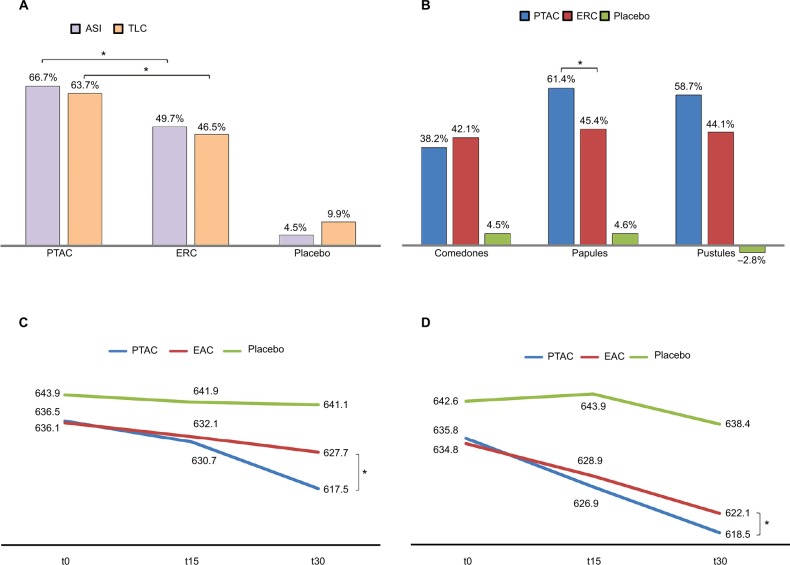Treatment of acne with a combination of propolis, tea tree oil, and Aloe vera compared to erythromycin cream: two double-blind investigations.
IF 3.1
Q2 PHARMACOLOGY & PHARMACY
Clinical Pharmacology : Advances and Applications
Pub Date : 2018-12-13
eCollection Date: 2018-01-01
DOI:10.2147/CPAA.S180474
引用次数: 44
Abstract
Introduction Antibiotics that suppress Propionibacterium acnes are the standard treatment for acne but are becoming less effective, due to the appearance of antibiotic-resistant strains. Many plants are known to have innate antimicrobial action and can be used as alternatives to antibiotics; thus, it is necessary to prove their effectiveness in vivo. This study aimed to evaluate the anti-acne efficacy of a new cream based on three natural extracts, comparing it to erythromycin cream and placebo. Patients and methods Sixty patients with mild to moderate acne vulgaris were randomly divided into three groups: treated with cream containing 20% propolis, 3% "tea tree oil", and 10% "Aloe vera" (PTAC) (n=20); or with 3 % erythromycin cream (ERC) (n=20); or with placebo (n=20). At baseline, after 15 and 30 days, investigators evaluated response to treatment by counting acne lesions through noninvasive measurements and macrophotography. Results All the clinical and instrumental values studied were statistically different from placebo except for sebometry, pHmetry, and erythema index values, measured on healthy skin. Unlike in the placebo group, papular and scar lesions showed high erythema reduction after 15 and 30 days of PTAC and ERC application. Conclusion The PTAC formulation was better than ERC in reducing erythema scars, acne severity index, and total lesion count.

用蜂胶、茶树油和芦荟联合治疗痤疮与红霉素乳膏的比较:两项双盲研究。
引言:抑制痤疮丙酸杆菌的抗生素是痤疮的标准治疗方法,但由于抗生素耐药菌株的出现,效果越来越差。已知许多植物具有天然抗菌作用,可以用作抗生素的替代品;因此,有必要证明其在体内的有效性。本研究旨在评价一种基于三种天然提取物的新型乳膏的抗痤疮功效,并将其与红霉素乳膏和安慰剂进行比较。患者与方法:将60例轻中度寻常痤疮患者随机分为3组:使用含20%蜂胶、3%茶树油、10%芦荟(PTAC)乳膏治疗(n=20);或3%红霉素乳膏(ERC) (n=20);或安慰剂组(n=20)。在基线,15天和30天后,研究人员通过无创测量和微距摄影计算痤疮病变来评估治疗效果。结果:除了在健康皮肤上测量的皮脂测定法、血量测定法和红斑指数外,所有临床和仪器值与安慰剂相比均有统计学差异。与安慰剂组不同的是,PTAC和ERC应用15天和30天后,丘疹和疤痕病变的红斑明显减少。结论:PTAC制剂在减少红斑疤痕、痤疮严重指数和总病变数方面优于ERC制剂。
本文章由计算机程序翻译,如有差异,请以英文原文为准。
求助全文
约1分钟内获得全文
求助全文
来源期刊

Clinical Pharmacology : Advances and Applications
PHARMACOLOGY & PHARMACY-
CiteScore
4.60
自引率
0.00%
发文量
14
审稿时长
16 weeks
 求助内容:
求助内容: 应助结果提醒方式:
应助结果提醒方式:


